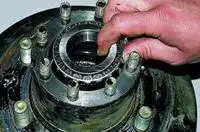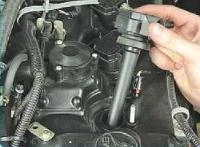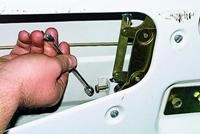Cooling system ZMZ-40524 - liquid, closed, with forced circulation of coolant
The engine cooling system consists of cooling jackets for cylinder block 6 and cylinder head 1, water pump 5 with electromagnetic clutch, thermostat 2, drain plug 7, control system coolant temperature sensor 3.
The circulation of the coolant in the system is created by a centrifugal water pump driven by the crankshaft.
The pump supplies liquid to the cooling jacket 6 of the cylinder block, from where the liquid enters the jacket 1 of the cylinder head and then to the thermostat housing 2.
Thermostat 2 automatically regulates the flow of coolant to the radiator depending on its temperature.
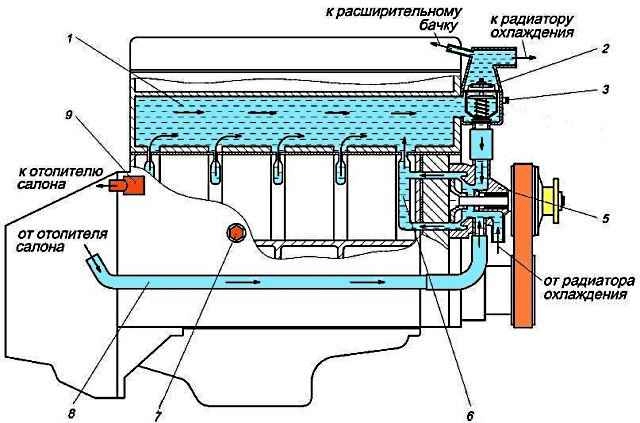
Through the fitting of the thermostat cover, air is discharged into the expansion tank when the system is filled and the steam that occurs in the cooling system.
The coolant is drained from the engine through the hole on the left side of the cylinder block, closed with plug 7.
The optimal temperature regime of the coolant in terms of minimum wear and fuel consumption lies within plus 80-90°С.
The temperature control of the engine is carried out using the temperature gauge and the overheating indicator (warning lamp), which are part of the instrument cluster of the car.
The coolant temperature gauge is controlled by a signal generated by the control unit based on information from temperature sensor 3 located in the thermostat housing.
In the instrument cluster of the car, information about the current engine temperature is taken from the coolant temperature gauge, and if the maximum permissible value of 105 ° C is exceeded, the coolant overheat warning lamp is ignited.
The indicator color is red.
Thermostat
Thermostat - with a solid filler, two-valve, with an automatic drain valve TC 107-05, TP 2-01 or TA 107-05.
The thermostat is located in an aluminum housing mounted on the outlet of the cylinder head cooling jacket and is connected by hoses to the water pump, radiator and expansion tank.
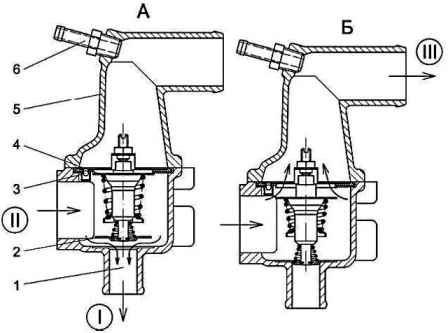
The thermostat automatically maintains the required temperature of the coolant in the engine, turning off and on the circulation of the liquid in a large circle through the radiator.
On a cold engine, the main thermostat valve 4 is closed, and all the coolant circulates through the open bypass valve 2 of the thermostat to the water pump in a small circle, bypassing the radiator.
When the engine warms up and the coolant temperature rises to plus 82 ± 2° C, the main thermostat valve starts to open, and the bypass valve closes.
At the same time, part of the coolant begins to circulate in a large circle through the cooling radiator.
At a temperature of plus 97±2 °C, the main valve is fully open by at least 8.5 mm, the bypass valve is closed and all the coolant circulates through the radiator in a large circle.
In the flange of the thermostat there is a hole with an automatic drain valve 3.
The hole is used to release air when filling the cooling system
When the engine is running, the water pump creates fluid pressure, under the action of which the valve ball rises and closes the hole, preventing fluid from leaking into the radiator.
The tightness of the connection between the thermostat cover and the housing is ensured by a U-shaped rubber gasket installed on the thermostat flange.
The thermostat in the housing must be installed in such a way that the protrusion on the thermostat post fits into the groove of the housing, which provides the least resistance to the flow of coolant.
It is forbidden to operate the engine without a thermostat, which will lead to engine overheating in summer, to long warm-up and engine operation at reduced temperature in winter temperature mode
The maintenance of the operating temperature in the cooling system by the thermostat has a decisive influence on the wear of engine parts and the efficiency of its operation.
Possible malfunctions of the cooling system and how to fix them
Engine is overheating
Radiator core clogged with dirt and insects - Wash the outside of the radiator core. Blow out with compressed air
Low coolant level in expansion tank - Locate the coolant leak.
Fix the leak. Add coolant
Thermostat defective (valve stuck closed) - Replace thermostat
Water pump faulty - Check pump, replace if faulty
Damage of the valve in the cap of the expansion tank (the valve is constantly open, due to which the system is under atmospheric pressure) - Replace the cap of the expansion tank
Radiator pipes, hoses and engine cooling jacket clogged with scale and sludge - Flush the cooling system and fill with fresh coolant
The engine overheats, cold air comes out of the heater
Excessive coolant drop due to leaking or damaged cylinder head gasket,
causing vapor lock in the engine water jacket - Repair the coolant leak. Replace damaged cylinder head gasket
The engine does not warm up to operating temperature for a long time, the thermal regime is not stable while driving
Thermostat defective (valve stuck open) - Replace thermostat
Continuous drop in coolant level in the expansion tank
The radiator is leaking - Replace the radiator
Expansion tank leaking - Replace expansion tank
Coolant leaks through leaky pipe and hose connections - Tighten the hose clamps
Water pump seal damaged - Replace water pump
Water pump housing seal damaged - Replace seal
Insufficiently tightened cylinder head bolts (during long-term parking on a cold engine
A coolant leak appears at the junction between the cylinder head and the cylinder block) - Tighten the cylinder head bolts to the required torque








